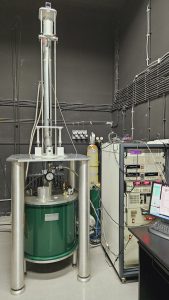Laboratory for magnetic measurements is equipped with a 14 T cryogen free High Magnetic Field Measurement System (a superconducting magnet with a vibrating sample magnetometer, a resistivity and Hall effect set-up, and a specific heat system).
High Magnetic Field Measurement System
The High Magnetic Field Measurement System (HMFMS) made by Cryogenic Ltd. is a very versatile system for various experiments and measurements in high magnetic fields up to 14 T, within the temperature range from 1.6 K to 325 K. The HMFMS is capable of measuring several physical quantities:
- Magnetic moment and magnetization using a Vibrating Sample Magnetometer (VSM)
- AC Susceptibility
- Electrical resistivity
- Hall Effect constant
- Specific Heat

14 tesla cryogenic free measuring system.
The HMFMS is a “cryogen free system”, meaning it does not use liquid helium for cooling superconducting magnets. Instead, it uses a closed cycle system of helium gas cooling with a compressor. In the core of the system is a superconducting magnet, based on a NbTi/Nb3Sn alloy. The magnet is able to achieve magnetic fields of up to 14 T. The sample is mounted on a probe which is placed inside the Variable Temperature Insert which allows for sample temperature variation in the 1.6-325 K range.
By changing a probe holder it can be easily changed the type of measurement performed on the system, i.e., the system can be used in different configurations for different experiments. The system is using a LabView based software for monitoring and data collection which enables automated multisequence measurements.
Vibrating sample magnetometer
The Cryogenic VSM is a research instrument for measurements of the DC magnetic moment in the fields of up to 14 Tesla. In order to generate a signal proportional to the magnetic moment, the sample is set to vibrate in a constant (or slowly varying) applied field. This allows for measurement of the sample magnetic moment as function of magnetic field and/or temperature, in ranges from 0.001 to 14 T and 1.6-325 K.
AC susceptometer
The AC magnetic susceptibility of a sample is measured by applying a small AC field using a drive (or primary) field coil and detecting the sample response with a pair of pick-up (or secondary) coils. In that way, the in-phase, or real, component χ' and an out-of-phase, or imaginary, component χ" of susceptibility can be measured, as a function of temperature, and frequency (1 Hz – 20 kHz).
Electrical resistivity and Hall effect measurements
The Resistivity system is configured for 4-terminal resistance measurements and Hall voltage measurements in the range from μΩ to MΩ resistance. The resistance is measured by a high quality digital voltmeter and a current source. The standard sample platform is typically 15 mm x 50 mm with 8 electrical connections for two samples. Sample size is typically up to 10 mm.
Specific heat measurements
The Cryogenic Ltd. miniature AC calorimeter is designed to measure the heat capacity of samples weighing as little as one microgram.
The AC calorimeter is based on an AC technique that offers unsurpassed sensitivity combined with simplicity of operation. The sample is mounted onto the calorimeter membrane using thermally conductive vacuum grease mounted in a closed cell with low-pressure exchange gas. Typical sample dimensions are about 100 x 200 microns and mass about 1 -10 μg.